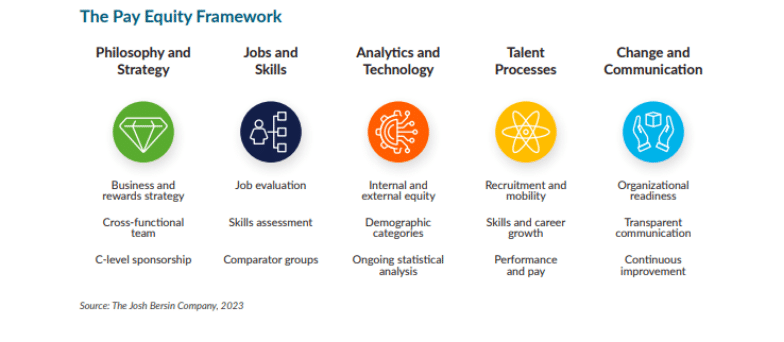5 Elements of the Pay Equity Framework

Here at Salary.com, we have commissioned The Josh Bersin Company to produce a report titled The Definitive Guide to Pay Equity. This report covers areas ranging from pay equity frameworks to a pay equity maturity model to help your organization better understand how they can implement pay equity within their compensation practices. As well as this, the report uses a pay equity study which consists of 448 companies and their 24 management and HR practices to bring you up-to-date and valid data.

In this article, we will take a look at the pay equity framework within the report. We will break down what the five elements are, as well as the dimensions within them. Without further ado, let’s get started by asking the question: what is the pay equity framework?
What is the Pay Equity Framework?
The pay equity framework identifies that there are five fundamental elements and fifteen dimensions when it comes to pay equity. It provides a comprehensive strategy and approach for organizations that want to achieve the goal of equal pay for equal work. Below you can see what the pay equity looks like.

As you can see, the five elements consist of:
- Philosophy & Strategy
- Jobs and Skills
- Analytics and Technology
- Talent Processes
- Change and Communication
Each of these elements is unique and provides insight into how your organization can approach pay equity in an effective way. It is vital to understand the deeper meanings of these elements and dimensions, however. As this is the case, let’s jump in and see.
Philosophy and Strategy
- Defining the business and rewards strategy
For philosophy and strategy, your organization must address questions about your organization’s mission, vision, and purpose. As well as this, your organization needs to answer questions about people-related strategies and how rewards systems support them. Examples include:
- Your approach to pay for performance.
- Where you pay in the range of the market.
- What other elements beyond base pay constitute your rewards packages in comparison to the market?
- Whether pay is differentiated by location.
- What value skills and additional contributions do to your compensation package.
- Convening a cross-functional team.
Convening a cross-functional team means that you bring together people from various groups across your organization to work on pay equity. An employer needs to empower its team to be able to make decisions about skills, jobs, and comparator groups. Your team needs to bring expertise across a variety of areas and drive change in the organization.
- Soliciting C-Level sponsorship
By identifying strong support and endorsement from the C-suite, it can enable comprehensive actions on identified pay equity issues. This can be a make-or-break point to differentiate outcomes.
Jobs and Skills
- Conducting a full job evaluation
When conducting a full job evaluation, you can analyze jobs to determine experiences, qualifications, and other requirements to determine what ‘equal work’ is. Conducting this analysis is vital to understanding pay equity. As well as this, you need to take the time to consider what factors should differentiate pay levels.
- Performing a comprehensive skills assessment
Review the different skill requirements for projects and assignments as a way of breaking down work into smaller components. This will be helpful to determine how pay should be allocated for skills acquisition or reskilling. These skills assessments have become more important in recent years as more organizations move to skills-based work models.
- Identifying comparator groups
When identifying comparator groups, you need to decide which groups of jobs, projects, or work assignments are comparable to use during pay equity audits. These comparator groups or similarly separated groups are typically broader than job codes and span more than job functions. Ensure that you take the time to differentiate jobs accordingly.
Analytics and Technology
- Analyzing internal and external equity
To analyze internal and external pay equity, you need to define a process for reviewing both internal and external equity. It can be challenging to bring both to the table at the same time – this will result in more actionable outcomes, however. Here at Salary.com, we have the technology to provide this capability in a single solution.
- Defining demographic categories
You need to determine which demographics will be used for pay equity audits. Demographics include (but aren’t limited to) gender, ethnicity, nationality, sexual orientation, and disability status. In fact, our research found that 84% of companies don’t expand their demographics beyond gender, which outlines how more demographic groups need to be addressed.
- Conducting ongoing statistical analysis
Statistical analysis should be ongoing in your organization. This can isolate issues while also using advanced statistical concepts and dedicated technology to scale the process. Only 14% of companies surveyed use specialized technology for pay equity and those that do are 3.2 times more likely to engage and retain employees and 7 times more likely to attract talent.
Talent Processes
- Reviewing processes related to recruitment and mobility
Your organization needs to determine if hiring and internal mobility introduce issues regarding pay equity. To avoid inequities at the time of hire, practices like removing questions relating to salary history or being transparent in communications can be used.
- Identifying issues in skills and career growth
Your organization needs to analyze developmental assignments, career opportunities, and learning for potential bias. For example, giving women lower-priority projects can lead to their future earning potential being damaged. On the other hand, by clearly defining training requirements for promotion opportunities or providing equitable development, your organization can put all employees on the same pedestal.
- Reviewing performance and pay
Organizations must identify and mitigate bias and inequities in processes relating to performance management, promotions, and performance-based pay. These processes are vital for addressing the root causes of inequities.
Change and Communication
- Reviewing organizational readiness
Your organization needs to identify and address opportunities and gaps in pay equity readiness in HR, leadership, managers, and employees. To do this, organizations can provide training to embrace pay equity as an organic part of work. The more education on the topic, the better the readiness of your organization.
- Focusing on transparent communication
When focusing on transparent communication, you need to be clear and open when talking about the strategy, plan, opportunities, and pay transparency in pay equity. This includes pay equity practices inside and outside the organization. Many companies struggle with this, which requires business-led communication about the goals and intentions of pay equity.
- Prioritizing continuous improvement
Your organization needs to act on issues and review the root causes of pay inequities. Continuous improvement also needs to develop sustainable processes for gradual pay equity improvement. For organizations who want to move forward, continuous improvement is a critical approach.
Conclusion
After breaking down each element and its dimensions, you can begin to build a picture of what your organization needs to do when approaching pay equity. In The Definitive Guide to Pay Equity, you can also find out what the 12 essential practices to pay equity are. For more insights and data, check out the report here.
Insights You Need to Get It Right







